This is another curious essay that might go some way to explaining how I came to find myself working in the field of colour. As has been written, I joined my father, Robert, in 1981 after a spell in the Army. Twenty years previously he had opened Papers and Paints and had focussed on colour and colour-matching. So far so good, and he trained me well, but it may be that the influence lies further afield.
His grandfather, Robert Polhill Bevan had made a career out of colour as an artist. Indeed, Sir Philip Hendy, Director of the National Gallery, in his preface to the 1961 Bevan retrospective exhibition at Colnaghi’s, commented that Bevan was perhaps the first Englishman to use pure colour in the 20th Century. He was not a very successful artist during his lifetime and I was fortunate to grow up with much of his work around me.
You can read all about Robert Bevan elsewhere so I won’t go into much detail.1 However, I do intend to show something of his use of colour and of his developing style by focussing on a few of his works.
As a brief background – Bevan was the fourth of six children of Richard Alexander Bevan and Laura Maria Polhill. The Bevans had been a Quaker family with long associations with Barclays Bank. He grew up on his father’s estate, Horsgate near Cuckfield, in Sussex, where they enjoyed a country lifestyle. The brothers belonged to two hunts and the family kept two packs of harriers. The artist’s easy familiarity with horses is evident in his work.
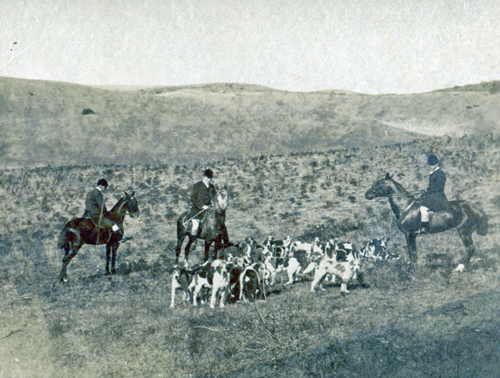
Bevan enroled at the Westminster School of Art and in 1889 he went to Paris where he studied for a year at the Académie Julian, the largest art school in the city. In 1890 he went to Pont-Aven, in Brittany, with his artist friend Eric Forbes-Robertson and while there he filled three sketch-books.2 After a visit to Tangier, he was back in Pont-Aven in 1893 where he worked with Gauguin, and Renoir encouraged him to draw horses. In July 1897 Bevan was in Jersey to attend Forbes-Robertson’s wedding and the bridesmaid was Stanislawa de Karlowska – the attraction between the two was immediate. He pursued her to her country home in Poland and the story goes that she was combing her hair when she heard the clatter of hooves in the courtyard and glimpsed Bevan through the window, dropping her comb in surprise. They were married in Warsaw on 9th December 1897 and their daughter Edith (my grandmother) was born in the following year. In 1900 they moved to London.
In 1910 Bevan exhibited for the first time at the New English Art Club and in the following years was heavily involved in the formation and exhibitions of the Camden Town Group. His involvement with Sickert’s circle began to be reflected in observations of everyday life from the Swiss Cottage area in which he lived. It was possibly Sickert who advised Bevan to exploit his love of horses in his work and it is these paintings of working horses in the cab and sale yards of Edwardian London for which Bevan is best remembered.
In his description of the painting at the top of this page the 1913 Horse Sale at the Barbican (Tate Britain) John Yeates wrote:
“(it) is pure Edwardian sporting imagery adapted and refined by Bevan to give a frieze of people held together by a strong sense of tone. The two horses depicted can be seen in many of the commercial images of the period, in a variety of situations, and would certainly be recognizable by the sporting “cognoscenti” of the time. The crowd around the rostrum employs another sporting convention: the use of body language to offset the lack of recognisable features in the crowd. The use of negative space also reflects the work of the sporting men. The ‘Barbican’ is a major twentieth century English painting”.3
As well as the constructional element made up by the use of overlapping triangles one can see a very sophisticated use of colour centred on the complementary red-brown and green overcoats either side of the main figure.
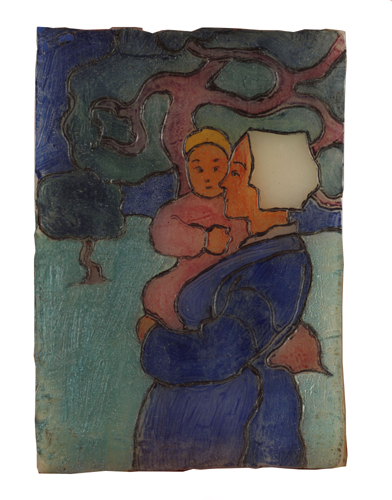
This is one of two curious works that Bevan produced following his time in Brittany. As Frances Stenlake has written:
“In addition to the mainly graphic work dating from the two Pont-Aven periods are two tiny wax panels which, although said by his son to be a technical experiment worked on in the evenings back in England, must be the products of Bevan’s acquaintance with one particular artist, the unhappy Charles Filiger. Filiger had arrived in Pont-Aven in July 1890, a month before Bevan and Forbes-Robertson, become friendly with the latter, and remained based in the area for the rest of his reclusive life…The incised designs of flat shapes of pure red, green and blue, outlined in black, suggest stained glass and the cloisonnist style developed by (Émile) Bernard and Louis Anquetin by the early summer of 1888.”4
Bevan’s use of colour was well in advance of any other English artist of the time. Of course, one of the problems that he experienced was the hostility and lack of comprehension by many who saw some of these early works.
“When, at the age of forty, Bevan showed this work at his first one-man exhibition in 1905, it attracted almost violent abuse. With its strong colour and dashing, fluid technique, it seems to anticipate the work of the French fauvists, although it does perhaps owe more to the influence of the painters surrounding Gauguin at Pont-Aven in Brittany where Bevan stayed, 1893-94. The British public were not yet ready for such modernism. The subject is a courtyard in Poland, probably on his father-in-law’s estate at Szeliwy, in Russian occupied territory, where the Karlowski family were substantial and industrious farmers and passionate patriots. Bevan felt an intense affection for them and their country, feelings similar to those he had had for the people of Brittany.
Although the painting attracted some more sympathetic notice when it was exhibited again in 1905, Bevan evidently lost confidence in the direction it pointed and never again produced so outstanding a painting of this type. Sir Philip Hendy, in his preface to the 1961 Bevan retrospective exhibition at Colnaghi’s, commented that Bevan was perhaps the first Englishman to use pure colour in the 20th Century. He was certainly far in advance of his Camden Town colleagues in this respect.5
The Courtyard is a remarkably advanced work and the outstanding painting of this period in his oeuvre. It has been seen by many commentators to have anticipated Fauvism by at least a year, and the contemporary reviews for its first showing in 1905 singled it out for violent abuse, presaging the wider response that would greet the exhibitions of Post-Impressionist and Fauve art later in the decade. These reactions clearly affected Bevan’s confidence and he moved his painting away from this direction. The strong colours and fluid paint-handling of The Courtyard were quite unlike anything else being produced by any British artist at the time, perhaps with the exception of Roderic O’Conor, and to the art establishment of 1905 it must have appeared to be at the very vanguard of the modern movement.
Frank Rutter had already praised Bevan’s pictures of this sort. When The Cab Horse was shown for the first time in 1910 he had singled it out in his Sunday Times review of the New English Art Club exhibition.6
The picture’s colouring was something on which almost all critical notices of The Cab Horse focussed their attention. Bevan’s colour scheme was extremely adventurous, using combinations of both complementary colours and contrasting colours, such as red with green. His choice and use of colours is reminiscent of pictures by the Fauve painters, and may be compared most closely with those of André Derain. Such works were virtually unseen in London before Roger Fry’s two Post-Impressionist exhibitions held in 1910 and 1912. But Bevan evidently kept up with artistic developments in Paris, his son writing that:
“In the years that followed their meeting, I believe that Gore, Gilman, and Bevan all had some influence on each, both in their use of colour and in their broadening of planes and masses. This was, of course, accelerated in 1910, when Gilman and Gore in London and Paris discovered the post-impressionists. But the painters who gave such a healthy shock to the London art world in Roger Fry’s post-impressionist exhibition in 1910 were not new to Bevan.7
During the last thirteen years of his life Bevan painted in Devon, in the area of the Blackdown Hills. It was at this time that one sees a flirtation with neo-Cubist forms:
“Of all the Camden Town Painters, Bevan found continual interest in the agrarian countryside. This aspect of his work is allied with a tradition of English landscape painting extending back to Turner and Constable but nevertheless his approach was always forward looking. This exceptional painting shows him engaged in a conscious process of pattern-making. Trees are treated as solid shapes of green, the fields are a series of angular planes and the clouds are outlined with jagged edges.8
This is one of my favourite Bevans. Some found his use of mauve and purple quite shocking, but I love it.
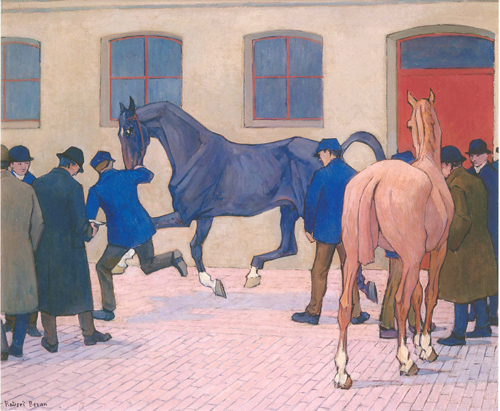
Another of my favourites and one of his best known works is this horse sale painting. Tattersall’s auctioned hunters and carriage horses, while the Barbican, Ward’s and Aldridge’s concentrated on hacks and horses for trader’s vehicles.
“Bevan painted angular, common horses in a most sensitive and individual style, frequently using straight lines which made the horses even more angular, and yet produced more feeling and suppleness in the horse than most artists are capable of. He was and is an outstanding artist of our time, important in his influence as an artist as well as a horse painter, and his use of colour and his draughtsmanship were both quite original.”9
Bevan produced about forty prints and his declared object according to his son was that he would render colour in black and white. This work, which was also the subject of a painting does that very well.10
“In 1908 the first exhibition of the Allied Artists’ Association, organised by Frank Rutter then a professional art critic writing in particular for the Sunday Times, introduced Bevan to the Fitzroy Street Group, centred round Sickert. The subject of the cab yard was perhaps taken up on Sickert’s advice or more generally inspired by the London scenes treated by other members of his circle. The settings for the cab yard pictures were Ormonde Terrace or Queen’s Terrace, both in St John’s Wood and within easy walking distance of Adamson Road. The care with which these were prepared can be seen in the corresponding pages of the sketchbooks which contain, besides studies of details such as horses’ legs, hooves and harness, exact measurements of wheels, shafts, etc.11
Here I have juxtaposed two works painted in the same year in Luppitt, the Devon village, where he had bought himself a small house in which to paint. By this stage he had softened the angular shapes and also his palette, although one still sees a certain stridency under sunlight. He was to die in the following year.
Works by him can be seen in most public collections throughout the country and here is a further selection. His wife is also well represented in public collections and a number of her works can be seen here.
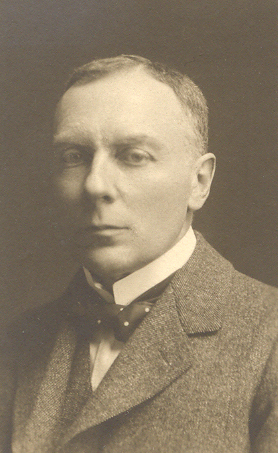
Notes
1 Much of this has been taken from the Tate online research project.
2 These are now in The Ashmolean Museum, Oxford.
3 John Yeates. NW1. The Camden Town Artists. A social history. Somerset, Heale Gallery. 2007.
4 Frances Stenlake. Robert Bevan: from Gauguin to Camden Town. London, Unicorn Press. 2008.
5 Christie’s. The Painters of Camden Town 1905-1920. 1988. p.48
6 Frank Rutter, ‘Round the Galleries: New English Art Club’, Sunday Times, 27th November 1910, p.2.
7 R.A. Bevan. Robert Bevan, 1865-1925: A memoir by his son. Studio Vista 1965. p.16.
8 Fine Art Society. A Family Collection from Boxted House 18 September – 2 October 2013. p.36.
9 Sally Mitchell. The Dictionary of British Equestrian Artists. The Antique Collectors’ Club. Suffolk. 1985. p.122.
10 R.A. Bevan ‘Memoir’ p.22.
11 Frances Stenlake. ‘Robert Bevan (1865-1925)’ The British Sporting Art Trust Essay No. 47. Spring 2006.

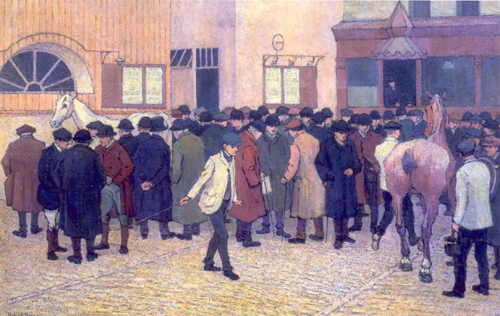
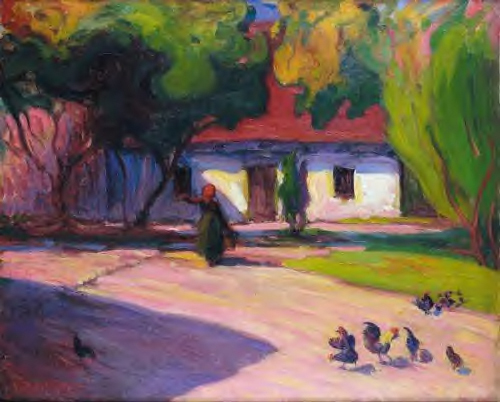
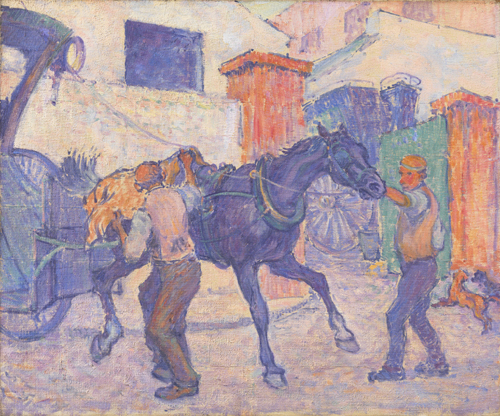
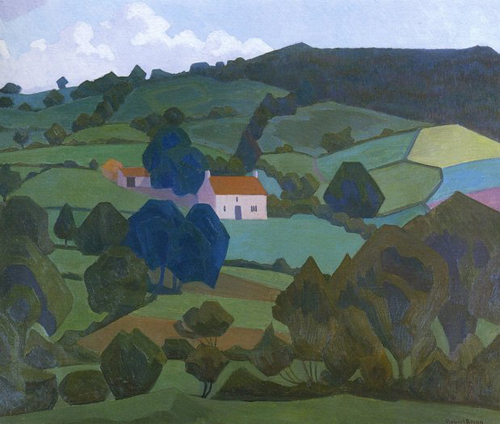

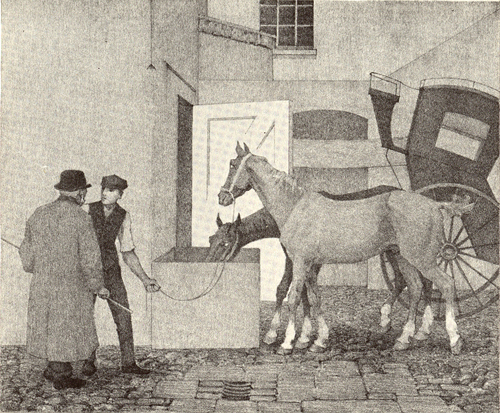
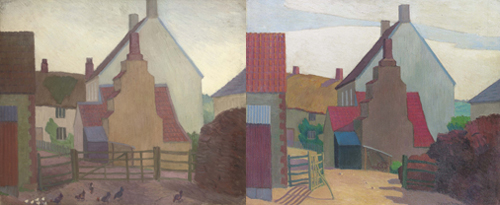










My grandfather was Frederick Richard Pyper – he was the Vicar of Nottingham at the time of his death in 1915. I recently became aware of a memoir about his life and have always wondered about the Bevan connection to our family,.My father was Walter Bevan Pyper. I was very interested to see the connection of Robert Bevan to the Pyper family. In the memoir it mentions the Barcleys and the Bevans – I always thought that the Bevans were part of my grandmother’s side. I am living in the US for many years but still have most of my family in England. I believe we must be related in some way? Kind Regards, Judy
Thanks for getting in touch. I have sent you an email.